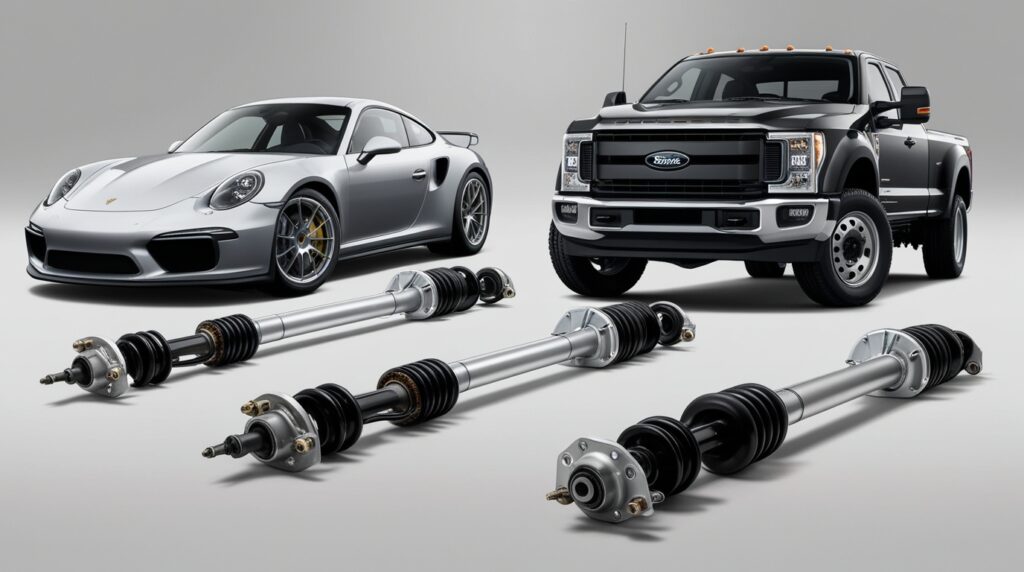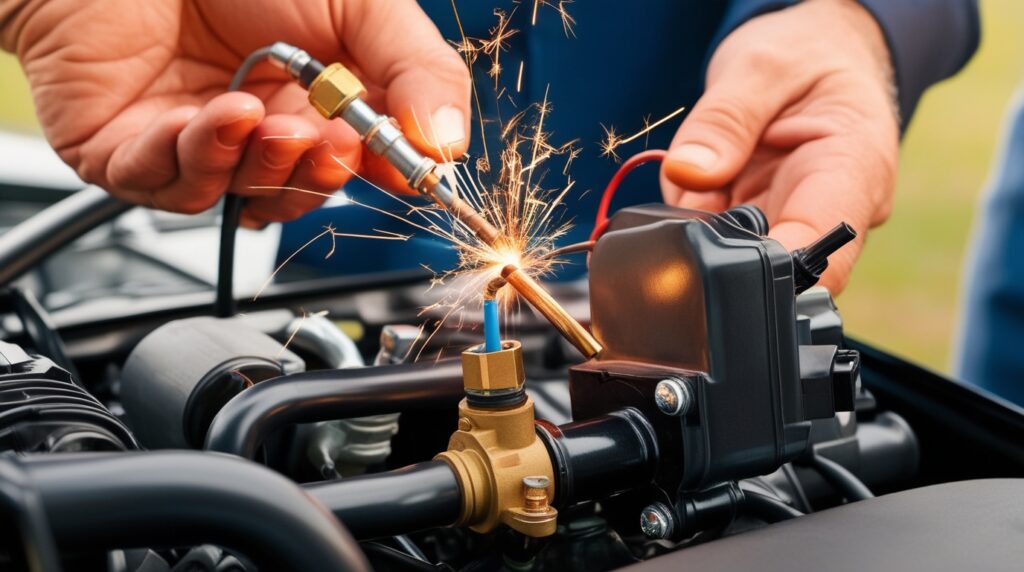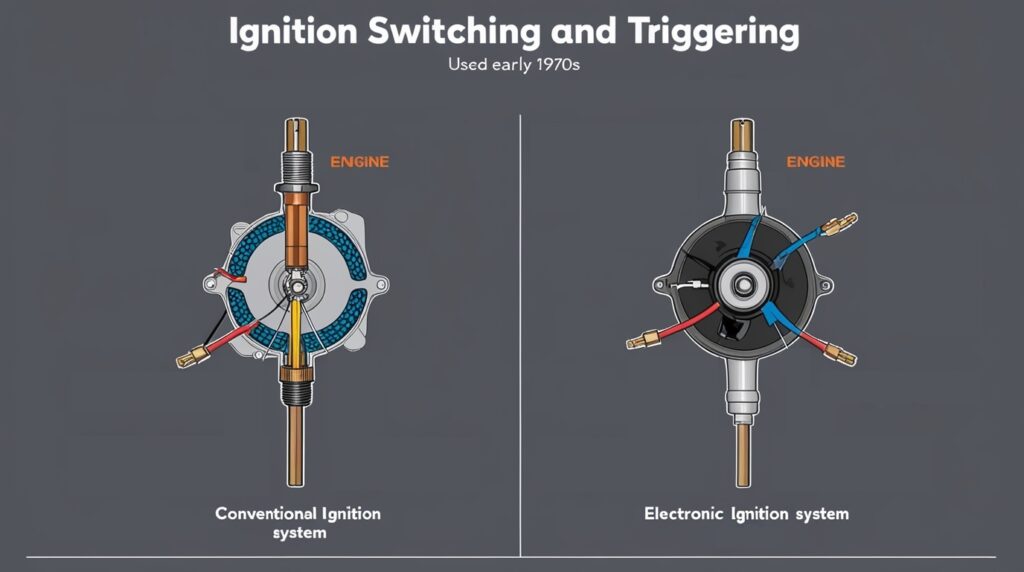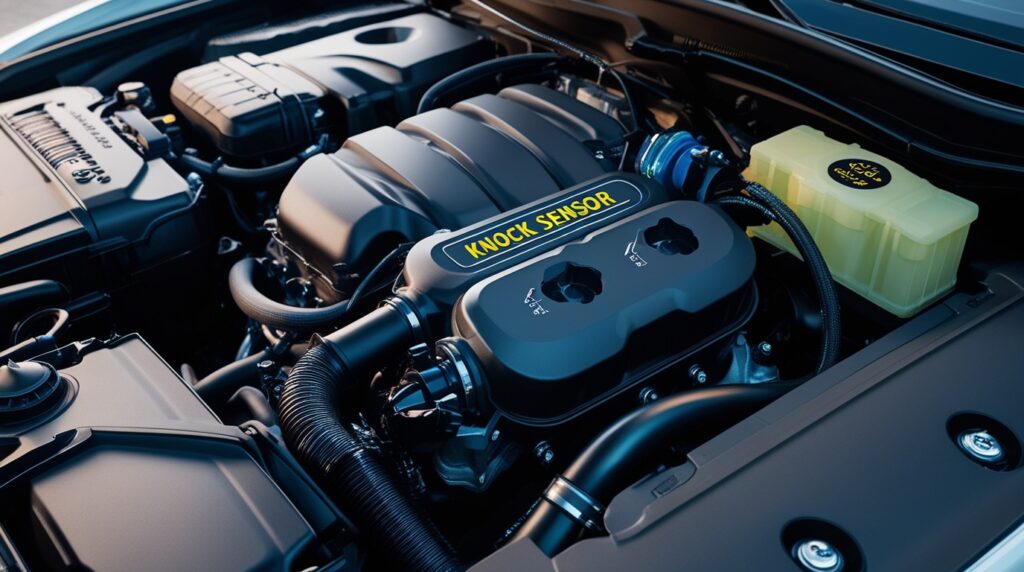Learn about the differences between Hotchkiss drive and torque tube drive systems in vehicle mechanics, including how they transmit power and torque. Discover the role of the differential, propeller shaft, universal joint, and thrust member in power transmission.
In the world of automotive engineering, the method of transmitting power from the engine to the wheels plays a crucial role in a vehicle’s performance, efficiency, and handling characteristics. Two prominent driveline systems that have been used throughout automotive history are the Hotchkiss drive and the torque tube drive.
Understanding Driveline Systems
Before delving into the specifics of Hotchkiss and torque tube drives, it’s essential to understand the basic function of a driveline system in a vehicle.
Purpose of a Driveline System
The primary purpose of a driveline system is to transfer the rotational power generated by the engine to the driven wheels. This system must:
- Efficiently transmit power
- Accommodate changes in the distance between the transmission and the rear axle
- Allow for vertical movement of the rear axle
- Manage the torque reactions generated during acceleration and braking
Hotchkiss drive
The Hotchkiss drive is a rear-wheel drive system commonly used in cars and trucks. It consists of a differential, propeller shaft, universal joints, and a thrust member. The differential allows the wheels to rotate at different speeds, while the propeller shaft transmits power from the gearbox to the differential. The universal joints allow for the flexing of the propeller shaft, while the thrust member helps to counteract the thrust from the propeller shaft.
The Hotchkiss drive is the simplest of the drive systems and is the most widely used. The arrangement of the parts can be seen in the picture.
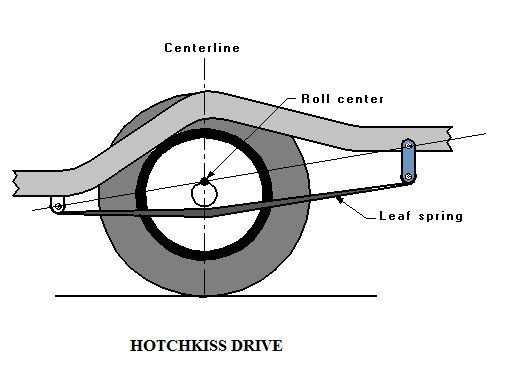
The suspension spring are bolted rigidly to the rear axle casing. The front ends of the springs are pivoted on pins. These pins are carried in brackets bolted to the vehicle frame. The rear ends of the springs are connected to the frame by swinging links or shackles. This arrangement permits the deflection of the spring when the vehicle is accelerated or braked. The propeller shaft is provided with two universal joints one at each end and a sliding joint at one end. This arrangement permits the rear axle assembly to move up and down due to projections and depression on the road surface.
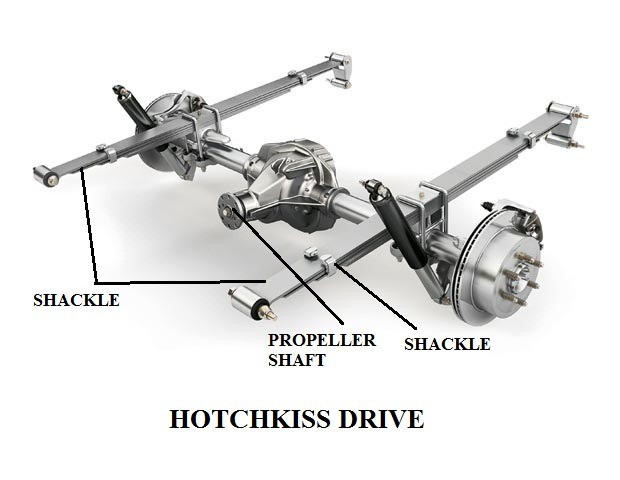
Engine power is always transmitted from the gear box to the final drive in the differential, through the propeller shaft. From the differential the driving torque is transmitted to the road wheels through the axle shafts. In this transmission system, the suspension springs act as torque and thrust members.
Design and Components
The Hotchkiss drive system consists of the following main components:
- Driveshaft (or propeller shaft)
- Universal joints
- Leaf springs
- Differential
In this system, the driveshaft is connected to the transmission output shaft and the differential input shaft using universal joints. The rear axle is suspended using leaf springs, which also serve to locate the axle and manage the torque reactions.
Advantages of Hotchkiss Drive
- Simplicity: The design is straightforward, making it easier to manufacture and maintain.
- Cost-effectiveness: Fewer components result in lower production costs.
- Lightweight: The system is generally lighter than alternative designs.
- Flexibility: It can accommodate a wide range of suspension travel.
Disadvantages of Hotchkiss Drive
- Noise and vibration: The system can transmit more road noise and vibration to the vehicle body.
- Axle tramp: Under heavy acceleration, the rear axle can experience a phenomenon known as axle tramp, causing wheel hop.
- Limited torque capacity: Very high-powered vehicles may exceed the torque capacity of this system.
Applications
The Hotchkiss drive has been widely used in:
- Rear-wheel-drive passenger cars
- Light trucks and SUVs
- Some performance vehicles
Advantages and Disadvantages of Hotchkiss Drive
Hotchkiss drive systems are relatively simple and inexpensive to manufacture and maintain. They are also easy to repair, as they consist of fewer components than torque tube drive systems. However, they can be less efficient than torque tube drive systems, as they are subject to power loss due to the flexing of the propeller shaft.
Torque tube drive
The torque tube drive, which is still fairly widely used is shown in picture. There is a tubular member called torque surrounds the propeller shaft and is bolted to the rear axle casing. The front end of this member is spherical in shape. The spherical end fits in a cup bolted to a cross member of the vehicle frame. The torque tube incorporates bearings which supports the propeller shaft. The propeller shaft itself is usually made of hollow steel tubing which construction gives it a light weight and torsional strength.
The suspension leaf springs are bolted to the spring seats that are provided on the axle casing. Each end of the springs are shackled to the frame. The tubular member will transmit the thrust from the axle to the frame and will also take the torque reaction. Often radius rods are used to assist the torque tube to take the twist and thrust of the vehicle drive.
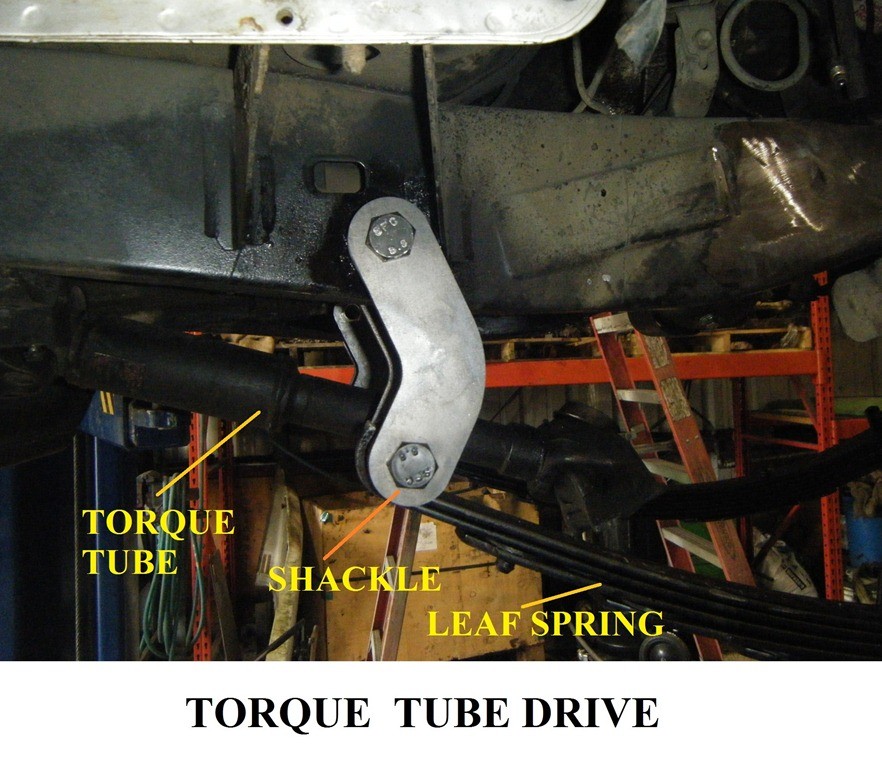
With this construction, the centre line of the final drive bevel pinion shaft will always pass through the centre of the spherical cup. Now, if the propeller shaft is connected to the gear box shaft by a universal joint situated exactly at the centre of that cup, no other universal joint will be needed and no sliding joint will be necessary. This is because both pinion shaft and propeller shaft will move about the same centre, namely that of the spherical cup, when the axle moves up and down.
In this system, the spring seats are sometime pivoted to the axle casing by means of spherical pivots. This relieves the springs of twisting stresses when the axle assumes angular positions relatively to the frame.
In one design, however, two extra heavy radius rods are used in place of the torque tube to take the thrust. They are connected between the rear axle housing and the X section of the car frame. An open propeller shaft and two universal joints are used with this design.
Design and Components
A torque tube drive system typically includes:
- Torque tube (a rigid housing enclosing the driveshaft)
- Single universal joint (at the transmission end)
- Sliding spline joint (at the differential end)
- Differential
- Rear axle housing
In this system, the driveshaft is enclosed within a rigid tube that connects the transmission to the rear axle housing. This tube transmits the torque reactions and helps locate the rear axle.
Advantages of Torque Tube Drive
- Reduced noise and vibration: The enclosed design helps isolate driveline noise and vibration.
- Improved axle control: The rigid connection between the transmission and rear axle provides better control and reduces axle tramp.
- Enhanced structural rigidity: The torque tube can contribute to the overall structural stiffness of the vehicle.
- Cleaner underbody: The enclosed design protects the driveshaft and allows for a smoother underbody.
Disadvantages of Torque Tube Drive
- Weight: The system is generally heavier than a Hotchkiss drive.
- Complexity: More complex design can lead to higher manufacturing and maintenance costs.
- Limited suspension travel: The rigid nature of the system can restrict suspension movement.
- Heat dissipation: The enclosed design may lead to heat buildup in high-performance applications.
Applications
Torque tube drive systems have been used in:
- Luxury vehicles (e.g., Mercedes-Benz)
- Some sports cars (e.g., early Chevrolet Corvettes)
- Certain racing applications
Advantages and Disadvantages of Torque Tube Drive
Torque tube drive systems are more complex and expensive to manufacture and maintain than Hotchkiss drive systems. However, they are more efficient, as they are less susceptible to power loss due to the flexing of the propeller shaft. They also provide better noise and vibration reduction than Hotchkiss drive systems.
How Power Transmission Works in Hotchkiss Drive
The Hotchkiss drive system uses a differential to divide power between the rear wheels. The differential is connected to the gearbox by a propeller shaft, which transmits power from the gearbox to the differential. The propeller shaft contains universal joints that allow for the flexing of the shaft as the wheels move up and down. The thrust member is a component that helps to counteract the thrust from the propeller shaft.
How Power Transmission Works in Torque Tube Drive
The torque tube drive system uses a torque tube to transmit power from the gearbox to the differential. The torque tube is a hollow tube that contains the propeller shaft and helps to reduce noise and vibration. The universal joint allows for the flexing of the propeller shaft, while the thrust member helps to counteract the thrust from the propeller shaft.
Comparative Analysis
When comparing Hotchkiss and torque tube drive systems, several factors come into play:
Performance Characteristics
- Power transmission efficiency:
- Hotchkiss drives generally offer slightly better efficiency due to fewer components.
- Torque tube systems may experience minor power losses due to the additional bearings and seals.
- Handling and stability:
- Torque tube systems often provide better axle control and reduced wheel hop.
- Hotchkiss drives can offer more compliant ride characteristics in some applications.
- Noise, Vibration, and Harshness (NVH):
- Torque tube systems typically excel in reducing NVH.
- Hotchkiss drives may transmit more road noise and driveline vibration to the vehicle interior.
Design Considerations
- Vehicle packaging:
- Hotchkiss drives offer more flexibility in suspension design and packaging.
- Torque tube systems may require specific design considerations for the vehicle’s structure.
- Weight distribution:
- Hotchkiss drives generally contribute to a lighter overall vehicle weight.
- Torque tube systems add weight but can improve weight distribution in some cases.
- Maintenance and repairs:
- Hotchkiss drives are generally simpler to maintain and repair.
- Torque tube systems may require more specialized knowledge and tools for maintenance.
Conclusion
Both Hotchkiss and torque tube drive systems have played significant roles in automotive history, each offering unique advantages and trade-offs. While modern vehicle designs often employ alternative solutions, understanding these classic driveline systems provides valuable insights into automotive engineering principles and the evolution of vehicle dynamics.
As the automotive industry continues to evolve, particularly with the rise of electric vehicles, we can expect to see further innovations in power transmission systems. However, the fundamental principles established by designs like the Hotchkiss and torque tube drives will continue to inform and influence future automotive engineering decisions.
